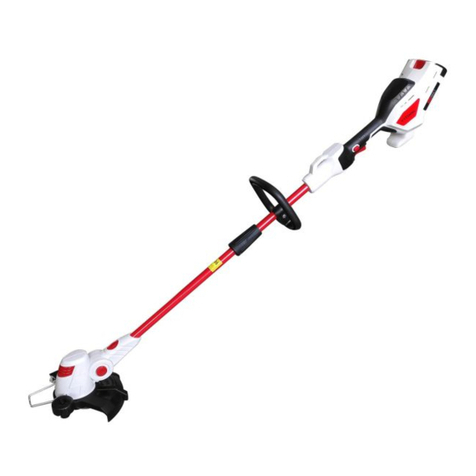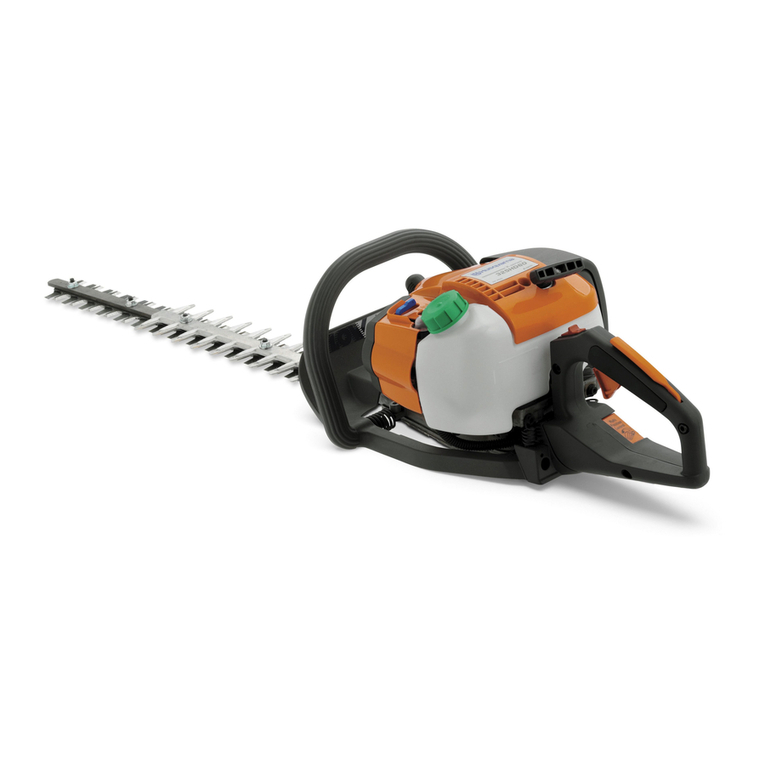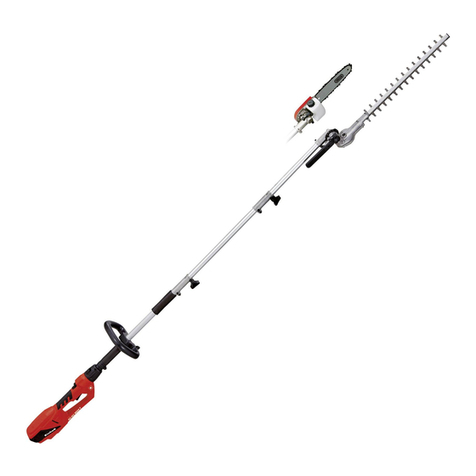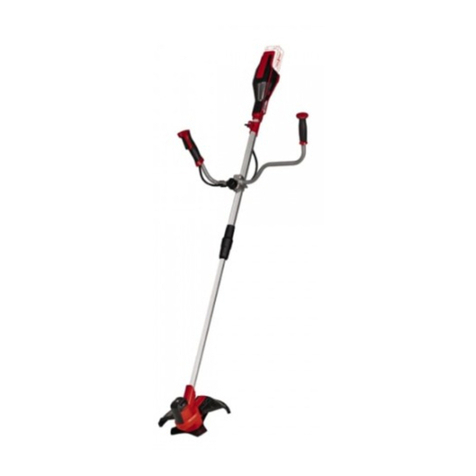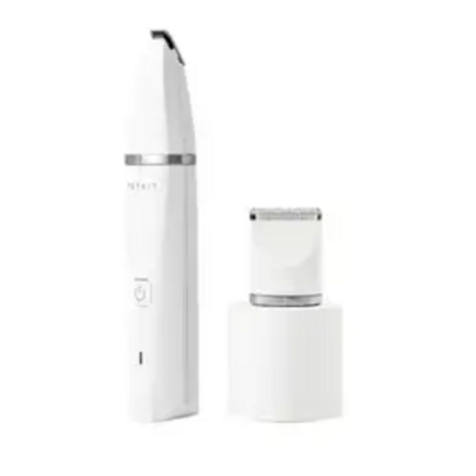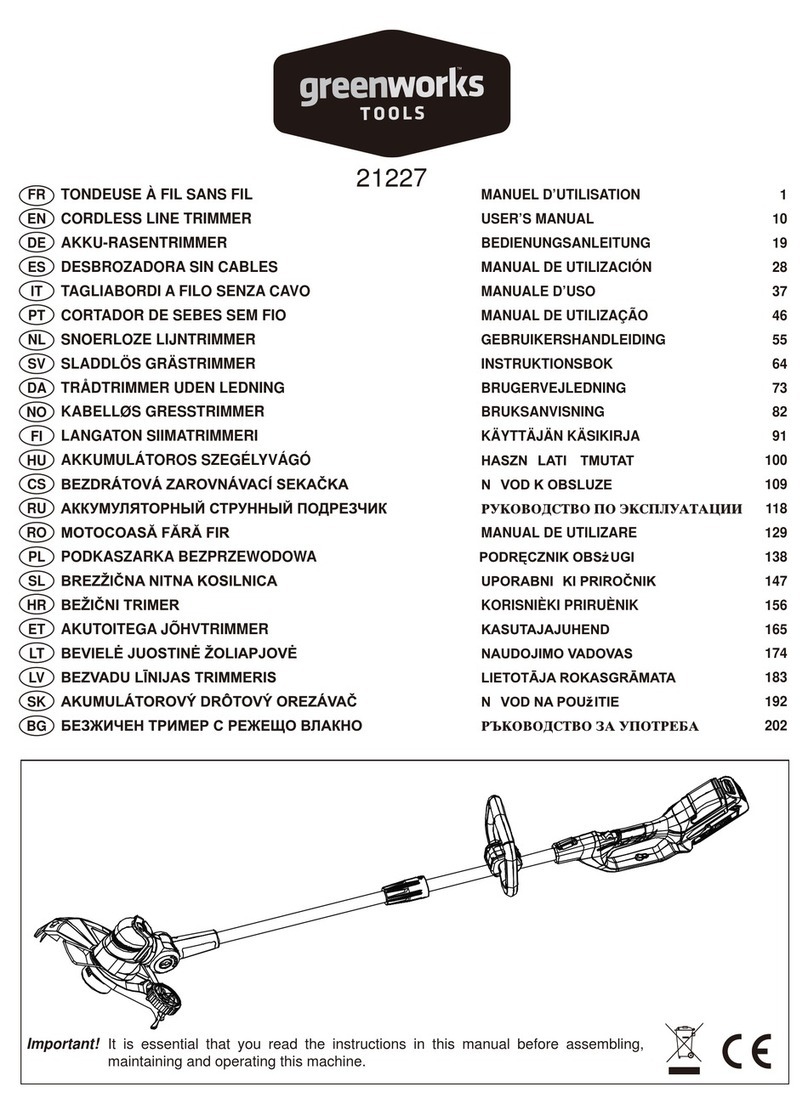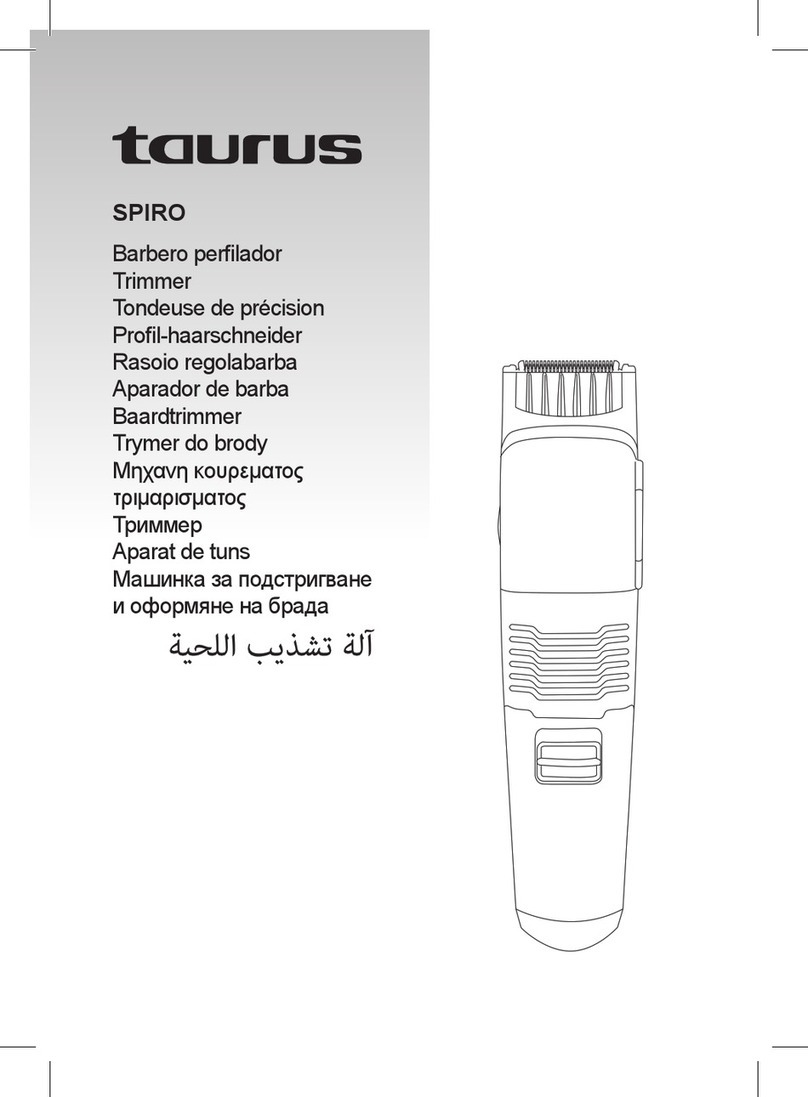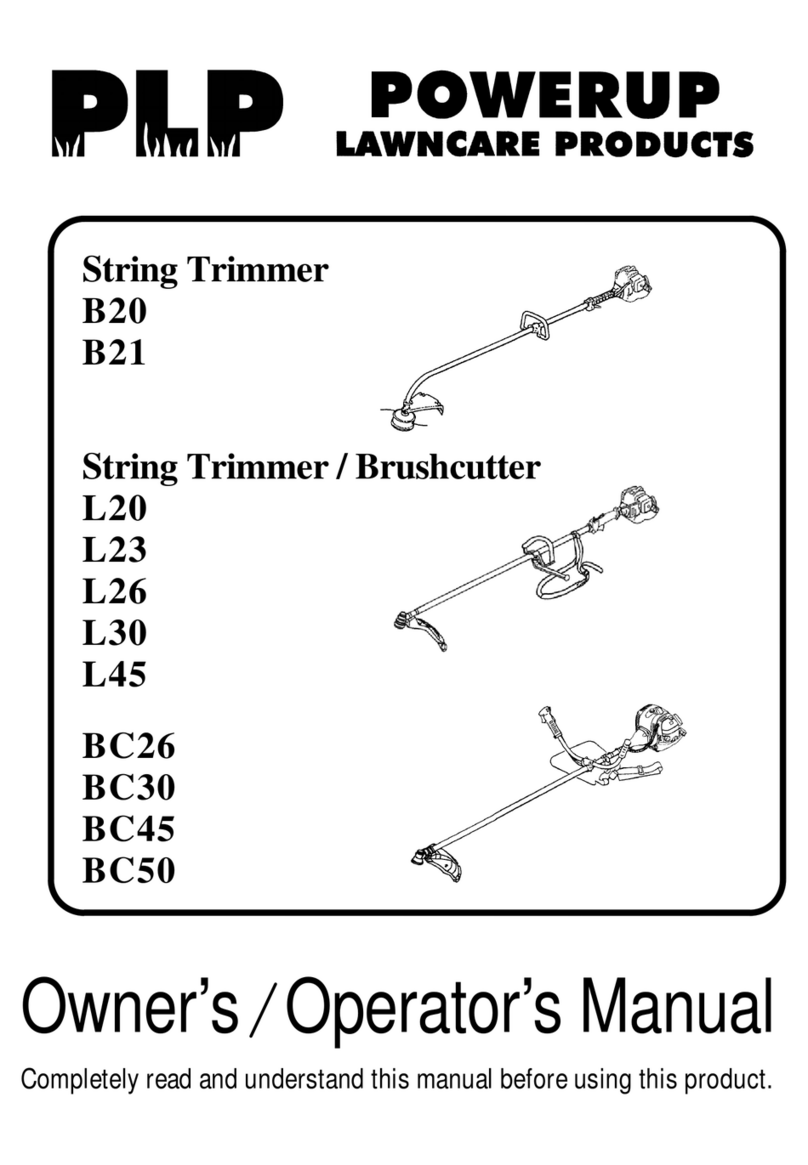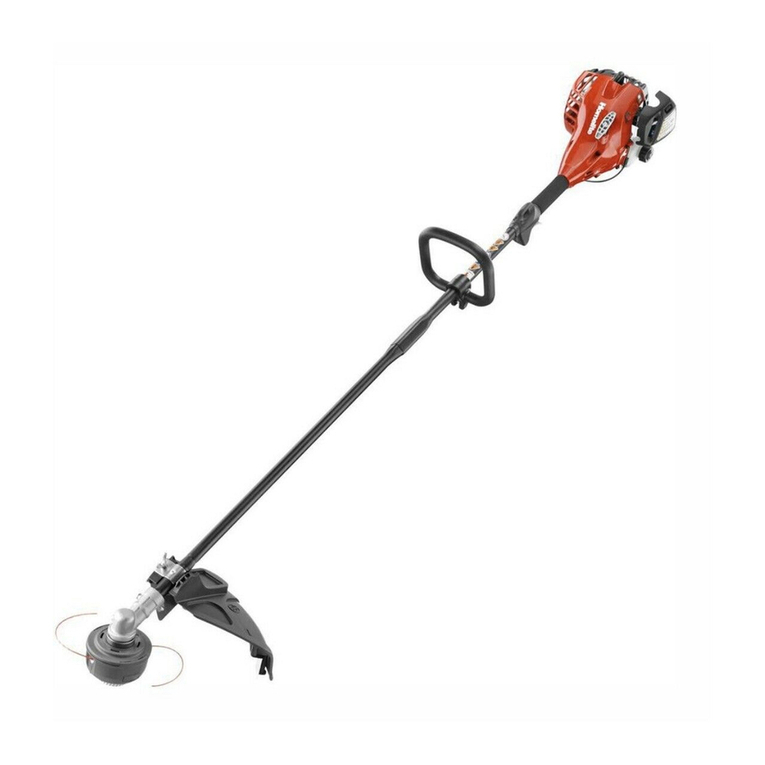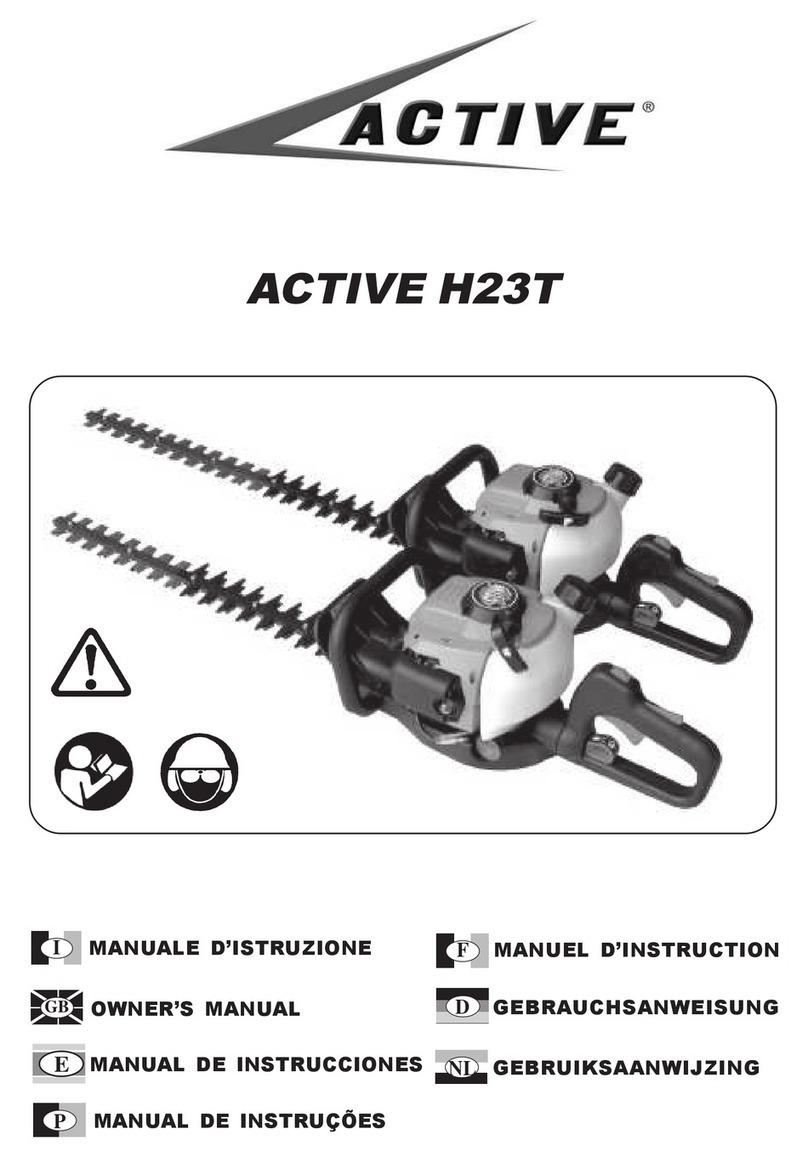VITINNI JK08014201 User manual

40V Battery Operated Cordless Hedge Trimmer
40V Batteriebetriebene Kabellose Heckenschere
PLEASE READ AND KEEP THESE INSTRUCTIONS FOR FUTURE USE
SAP Code: JK08014201
For further assistance, other products and more, join us at:
Website: www.vitinni.co.uk
Instagram: @vitinniuk
Facebook: www.facebook.com/vitinni

1
Thank you for choosing our Vitinni Battery Operated Cordless Hedge Trimmer.
Please read this user manual carefully and keep it for future reference. If you need
any assistance, please contact our customer service team on the details provided
on the back page of this manual.
Description of the Symbols
Caution! Read the following instructions carefully to familiarize yourself
with the controls and correct use of the hedge trimmer. Not using the hedge trimmer
in accordance with these instructions can cause serious injury. When using
electrical tools, obey the general safety instructions as well as the following safety
instructions in order to reduce the risks of fire, electric shock and injury.
Read the operator’s manual.
Before any use, refer to the corresponding paragraph in the present manual.
Conforms to European standards.
These symbols indicate the requirement of wearing eye protection, ear protection
and gloves when using the product.
Wear safety boots.

Do not expose to rain.
Keep bystanders away.
Recycle unwanted materials instead of disposing of them as waste. All tools, hoses
and packaging should be sorted, taken to the local recycling centre and disposed of
in an environmentally safe way.
2

General Safety Warnings
WARNING! Read all safety warnings and all instructions.
Failing to follow the warnings and instructions may result in an electric shock, fire
and/or a serious injury.
Save all warnings and all instructions for future reference.
The term “power tool” in the warnings refers to your battery-operated (cordless)
power tool.
1. Work Area Safety
a) Keep the work area clean and well lit. Cluttered or dark areas may cause
accidents.
b) Do not operate power tools in explosive atmospheres, such as in the presence of
flammable liquids, gases or dust. Power tools create sparks which may ignite the
dust or fumes.
c) Keep children and bystanders away while operating a power tool. Distractions can
cause you to lose control.
2. Electrical Safety
a) Charger tool plugs must match the outlet. Never modify the plug in any way. Do
not use adapters with earthed (grounded) power tools. Unmodified plugs and
matching outlets will reduce the risk of electric shock.
b) Avoid any body contact with earthed or grounded surfaces such as pipes,
radiators, ranges and refrigerators. There is an increased risk of electric shock if your
body is earthed or grounded.
c) Do not expose power tools to rain or wet conditions. Water entering a power tool
will increase the risk of electric shock.
3

3. Personal Safety
a) Stay alert, watch what you are doing and use common sense when operating a
power tool. Do not use a power tool while you are tired or under the influence of
drugs, alcohol or medication. A moment of inattention while operating power tools
may result in serious personal injury.
b) Use personal protective equipment. Always wear eye protection. Protective
equipment such as dust mask, non-skid safety shoes, hard hat, or hearing
protection used for appropriate conditions will reduce personal injuries.
c) Prevent unintentional starting. Ensure the switch is in the off-position before
connecting to the battery pack, picking up or carrying the tool. Carrying power tools
with your finger on the switch or energising power tools that have the switch on
invites accidents.
d) Remove any adjusting key or wrench before turning the power tool on. A wrench
or a key left attached to a rotating part of the power tool may result in personal
injury.
e) Do not overreach. Keep proper footing and balance at all times. This enables
better control of the power tool in unexpected situations.
f) Dress properly. Do not wear loose clothing or jewellery. Keep your hair, clothing
and gloves away from moving parts. Loose clothes, jewellery or long hair can be
caught in moving parts.
g) If devices are provided for the connection of dust extraction and collection
facilities, ensure these are connected and properly used. Use of dust collection can
reduce dust-related hazards.
4. Power Tool Use and Care
a) Do not force the power tool. Use the correct power tool for your application. The
correct power tool will do the job better and safer at the rate for which it was
designed.
b) Do not use the power tool if the switch does not turn it on and off. Any power
tool that cannot be controlled with the switch is dangerous and must be repaired.
c) Remove the battery from the battery pack from the power tool before making
any adjustment, changing accessories, or storing power tools. Such preventive
safety measures reduce the risk of starting the power tool accidentally.
4

d) Store idle power tools out of the reach of children and do not allow persons
unfamiliar with the power tool or these instructions to operate the power tool. Power
tools are dangerous in the hands of untrained users.
e) Maintain power tools. Check for misalignment or binding of moving parts,
breakage of parts and any other condition that may affect the power tool’s operation.
If damaged, have the power tool repaired before use. Many accidents are caused by
poorly maintained power tools.
f) Keep cutting tools sharp and clean. Properly maintained cutting tools with sharp
cutting edges are less likely to bind and are easier to control.
g) Use the power tool in accordance with these instructions, taking into account the
working conditions and the work to be performed. Use of the power tool for
operations different from those intended could result in a hazardous situation.
5. Battery Tool Use and Care
a) Recharge only with the charger specified by the manufacturer.
b) Use power tools only with battery pack specified by the manufacturer.
c) When battery pack is not in use, keep it away from other metal objects, like paper
clips, coins, keys, nails, screws or other small metal objects, that can make a
connection from one terminal to another. Shorting the battery terminals together
may cause burns or a fire.
d) Under abusive conditions, liquid may be ejected from the battery; avoid contact. If
contact accidentally occurs, flush with water. If liquid contacts eyes, additionally
seek medical help. Liquid ejected from the battery may cause irritation or burns.
e) Do not use a battery pack or tool that is damaged or modified. Damaged or
modified batteries may exhibit unpredictable behaviour resulting in fire, explosion or
risk of injury.
f) Do not expose a battery pack or tool to fire or excessive temperature. Exposure to
fire or temperature above 130 °C may cause explosion.
5

6
g) Follow all charging instructions and do not charge the battery pack or tool
outside the temperature range specified in the instructions. Charging improperly or
at temperatures outside the specified range may damage the battery and increase
the risk of fire.
6. Service
a) Have your power tool serviced by a qualified repair person using only identical
replacement parts. This will ensure that the safety of the power tool is maintained.
b) Never service damaged battery packs. Service of battery packs should only be
performed by the manufacturer or authorized service providers.
SAFETY ADVICE FOR RECHARGEABLE BATTERY AND CHARGER
• This appliance can be used by children aged from 8 years and above and
persons with reduced physical, sensory or mental capabilities or lack of experience
and knowledge if they have been given supervision or instruction concerning use of
the appliance in a safe way and understand the hazards involved. Children shall
not play with the appliance. Cleaning and user maintenance shall not be made by
children without supervision.
• For outdoor use only
• Warning! do not recharge non-rechargeable batteries
• This charger should be used only to charge the battery pack for this product.
WARNING! During the use of tools supplied with batteries, the basic safety
measures must be followed in order to reduce fire hazards, electrolyte leakage and
personal injury, including the following precautions:
Ensure that the battery pack is suitable for the tool before use.
Ensure that outside surface of the battery pack is clean and dry before connecting
it to the charger.
Ensure that the batteries are charged using the correct charger recommended by
the manufacturer. Incorrect use can create a risk of electric shock, overheating or
the leaking of corrosive liquid from the battery.

If there is an electrolyte leak, avoid any contact with the skin. In the event of a leak,
wipe with a rag. If the liquid comes into contact with the skin, rinse abundantly with
water. In the event of a reaction or contact with the eyes or mucous membranes,
consult a doctor.
Ensure that the appliance is properly switched off before inserting the battery into
the appliance. Inserting a battery into an appliance while it is switched on can
cause accidents.
Use the appliance only with the type of battery indicated in the instructions. Using
another type of battery can create a serious risk of injury and cause a fire.
Disposal of Batteries
Ensure that the battery is properly disposed of:
1-Do not throw it away
2-Do not to burn it
3-Do not throw it in a river
4-Dispose of it in the designated collection containers (ask your retailer)
Hedge Trimmer Safety Warnings
Keep all parts of your body away from the cutter blade. Do not remove cut material
or hold material to be cut when blades are moving. Make sure the switch is off
when clearing jammed material. A moment of inattention while operating the hedge
trimmer may result in serious personal injury.
Carry the hedge trimmer by the handle with the cutter blade stopped. When
transporting or storing the hedge trimmer always fit the cutting device cover.
Proper handling of the hedge trimmer will reduce possible personal injury from the
cutter blades.
Hold the power tool by insulated gripping surfaces only, because the cutter blade
may contact hidden wiring or its own cord. Cutter blades contacting a “live” wire
may make exposed metal parts of the power tool “live” and could give the operator
an electric shock.
Check the hedge trimmer free of foreign objects such as wire fences, metal wires,
latticework etc. before to start working with the hedge trimmer.
7

Hold the hedge trimmer properly, e.g. with both hands, one hand on each handle.
Intended Use
Cutting and trimming of hedges, bushes and ornamental shrubs in the domestic
sector only. Not designed for commercial use.
Tools for private and hobby gardens are not suitable for use in public facilities,
parks and sport centre, along roadways, on farms or in the forestry sector.
Technical Specifications
Noise/Vibration Information
Measured sound values determined according to EN 60745-2-15:2009+A1:2010.
Vibration total values (triax vector sum) determined according to EN 60745-2-15:
2009+A1:2010.
The vibration emission level given in this information sheet has been measured in
accordance with a standardized test given in EN 60745-2-15:2009+A1:2010 and
may be used to compare one tool with another.
It may be used for a preliminary assessment of exposure.
The declared vibration emission level represents the main applications of the tool.
However if the tool is used for different applications, with different accessories or
poorly maintained, the vibration emission may differ. This may significantly increase
the exposure level over the total working period.
8

An estimation of the level of exposure to vibration should also take into account the
times when the tool is switched off or when it is running but not actually doing the
job. This may significantly reduce the exposure level over the total working period.
Identify additional safety measures to protect the operator from the effects of
vibration such as: maintain the tool and the accessories, keep the hands warm,
organization of work patterns.
List of Main Parts
Charging process
NOTE: Batteries (not suppled) are not fully charged on delivery. Before first use,
fully charge the batteries.
Chargers (not supplied) are only suitable to charge the battery pack- BT4020. Do
not use the charger for any other battery pack.
9

10
Do not use this product in any other way as stated for normal use. Not observing
general regulations and instructions from this manual does not make the
manufacturer liable for damages.
CAUTION! Use only recommended batteries with the battery charger.
1. Put the battery into the slot of charger,Make sure the battery and charger is
fully connected.(Fig.1)
2. Insert the plug to mains. The LED flashes green and the battery is charging.
When the battery is fully charged, the LED lights green. (Fig.2)
3. To remove, press the release button and pull out the battery pack. (Fig.3)
4. Pull out the mains plug.
Charging indicator
The battery pack is equipped with 4 LED lights that will display the current battery
level by pressing battery indicator button (a).

11
Battery capacity display
4 green LED lights are constantly burning between 75% -100%.
3 green LED lights are constantly burning between 50% -75%.
2 green LED lights constantly burns between 25% -50%
1 green LED lights constantly burning lower than 25%
If no LED lights come on, even after pressing the indicator button, the battery is
defective and needs to be replaced.
For safety reasons, the capacity of the battery can only be checked when the
machine has come to a complete stop.
NOTE: Batteries may become warm while charging. This is normal. If the battery
is hot after continuous use in the tool, allow it to cool down to room temperature
before charging. This will extend the life of your batteries.
WARNING: Always disconnect the battery pack from the tool before any
assembly, adjustments or changing accessories.
Fitting And Removing The Battery Pack (Not Supplied)
To insert the battery pack, place it on the guide track and push it into the housing. It
will audibly snap in.
To remove the battery pack, just press the release button (a) and pull it out.

12
Starting:
Remove the blade protector before using the hedge trimmer.
Press the switch (9) on the rear handle and the front handle switch (5), you can
then start work.
Stop:
Release the front handle switch (5) or the switch (9) on the rear handle, you can
stop it.
Working With the Hedge Trimmer
Hold the hedge trimmer with both hands and keep it a safe distance away from your
body. Ensure that you always maintain a stable position. It is possible to cut
branches up to a maximum thickness of 28 mm. In order to approach branches with
the blades, move the hedge trimmer forwards straight along the line of the cut. Cut
the sides of the hedge first, then the top. In order to obtain a perfect shape, we
recommend you cut upwards in the direction of the growth. If you cut from top to
bottom, the thinner branches will move outwards leaving holes or less bushy
places.
In order to cut the top in a straight line, stretch a wire along the entire length of the
hedge at the desired height.
Take care not to cut foreign objects such as metal wires, latticework which would be
likely to damage the blades or the drive.
If the blades are jammed or blocked by an obstacle, switch off the appliance
immediately and remove the battery, and only then can you intervene to free the
appliance.
Rotary Handle Use
- To facilitate the use of hedge trimmers in vertical sections, the rear handle is
adjustable to the right and left.
- Handle position should be adjusted only when appliance is off.
- Press the handle rotation knob (7) down to unlock the handle and rotate to the
right or left to tilt chosen.
NOTE: The switch should not be actuated when rotate the rear handle.

13
NOTE: The switch should not be actuated when rotate the rear handle.
Tips For Using Hedge Trimmer
- Do not use in the rain
- Start the trimmer before being in contact with the hedge to prevent the blade being
blocked.
- For hedge trimmeing, alternate using the two sides of the blade.
- For efficiency, tilt the blade about 10 degrees without poking the tip of the trimmer.
- For horizontal areas, go from the inside to the edge of the hedge to cut down the
branches on the ground.
- If the height of the hedge is excessive, making several passes. Between each
size, cut large branches with pruning shears or a lopper.
- Work carefully nearby fences to avoid blocking the blade.
- In case of blade blocking, stop the machine and remove the battery before
cleaning.
Season for cutting hedges:
It is recommended to cut leafy hedges in June and October.
Coniferous hedges in April and August.
Cut other hedges that grow quickly every 6 weeks starting in May.

Maintenance
Before carrying out any maintenance work, remove the battery.
Note: In order to ensure long and reliable use of the product, carry out the
following maintenance work at regular intervals.
Check the hedge trimmer at regular intervals to detect visible defects such as a
detached, loose or damaged blade support bar, loose connections or worn or
damaged parts.
Check that the covers and safety devices are not damaged and that they are
correctly fitted. The repair or maintenance work needed must be carried out before
using the hedge trimmer.
Cleaning and Maintenance of the Blades
Before carrying out any maintenance work, remove the battery.
When handling or cleaning the blades, wear protective gloves.
Cleaning the blades after every use and treat them with a maintenance spray.
When the work is of rather long duration, we recommend lubricating the blades at
regular intervals using a maintenance spray. Carry out a visual inspection to
determine the condition of the blades.
14

Storage
Clean the external parts of the hedge trimmer using a soft brush and a cloth. Do not
use water, a solvent or an abrasive detergent. Remove all dirt that adheres to the
hedge trimmer and in particular on the motor ventilation vents.
Store the hedge trimmer in a dry and safe place, out of the reach of children. Do not
place other objects on top of the appliance.
Troubleshooting
15

Customer Services:
If you would like further advice or information on your product, ensure you have the
SAP code ready and please get in touch with us at Vitinni on the contact options
below:
SAP Code: JK08014201
Phone: 0330 002 1600 (Mon –Fri 9am to 5pm)
Email: support@vitinni.co.uk
Address: Vitinni, Vale Mill (Rochdale) Ltd, Robinson Street, Rochdale, OL16 1TA
Guarantee
Our products are guaranteed for a period of 2 years from the date of purchase. Products that
develop a fault within this period are covered by our warranty and we will replace defective
parts, or where not available the whole product. The warranty does not apply to any defect in
the goods arising from fair wear and tear, wilful damage, accident, negligence by you or any
third party, use otherwise than as recommended by us, failure to follow our instructions, any
alteration or repair carried out without our approval or has been the subject of commercial use.
Your statutory rights remain unaffected, in particular any rights you have under the Consumer
Rights Act 2015.
If you have a problem with your product within this warranty period please contact our
customer services team.
In the event of changes to the specification of a product and we are not able to replace parts,
we will replace the whole product within the 2 year guarantee period
For products that fall outside of the 2 year guarantee, we will endeavour to provide spare parts
to purchase for as many of the replaceable parts as possible, but cannot foresee specification
changes or upgrades to products or parts outside of the initial 2 year period.
16

17
Vielen Dank, dass Sie sich für unsere batteriebetriebene Akku-Heckenschere von Alfresia
entschieden haben. Bitte lesen Sie diese Bedienungsanleitung sorgfältig durch und bewahren
Sie sie zum späteren Nachschlagen auf. Wenn Sie Hilfe benötigen, wenden Sie sich bitte an
unseren Kundendienst. Die Einzelheiten finden Sie auf der Rückseite dieses Handbuchs.
Beschreibung der Symbole
Vorsicht! Lesen Sie die folgenden Anweisungen sorgfältig durch, um sich mit den
Bedienelementen und der korrekten Verwendung der Heckenschere vertraut zu machen.
Wird die Heckenschere nicht gemäß dieser Anleitung verwendet, kann dies zu schweren
Verletzungen führen. Beachten Sie bei der Verwendung von Elektrowerkzeugen die
allgemeinen Sicherheitshinweise, sowie die folgenden Sicherheitshinweise, um die Gefahr
von Feuer, Stromschlag und Verletzungen zu verringern.
Lesen Sie die Bedienungsanleitung.
Lesen Sie vor jeder Verwendung den entsprechenden Abschnitt in diesem Handbuch.
Entspricht den europäischen Normen.
Diese Symbole weisen darauf hin, dass beim Gebrauch des Produkts Augenschutz,
Gehörschutz und Handschuhe getragen werden müssen.
Tragen Sie Sicherheitsstiefel/-schuhe.

18
Nicht dem Regen aussetzen.
Halten Sie umstehende Personen fern.
Recyceln Sie unerwünschte Materialien, anstatt sie als Abfall zu entsorgen. Alle
Werkzeuge, Schläuche und Verpackungen sind zu sortieren, dem örtlichen
Recyclingzentrum zuzuführen und umweltgerecht zu entsorgen.

19
Allgemeine Sicherheitshinweise
WARNUNG! Lesen Sie alle Sicherheitshinweise und andere Anweisungen.
Die Nichtbeachtung der Warnungen und Anweisungen kann zu Stromschlägen,
Bränden und / oder schweren Verletzungen führen.
Bewahren Sie alle Warnungen und Anweisungen zum späteren Nachschlagen auf.
Der Begriff “Elektrowerkzeug” in den Warnungen bezieht sich auf Ihr
akkubetriebenes (kabelloses) Elektrowerkzeug.
1. Sicherheit für den Arbeitsbereich
a) Halten Sie den Arbeitsbereich sauber und gut beleuchtet. Überfüllte oder dunkle
Bereiche können zu Unfällen führen.
b) Betreiben Sie Elektrowerkzeuge nicht in explosionsgefährdeten Bereichen, wie
z.B. in Gegenwart von brennbaren Flüssigkeiten, Gasen oder Staub.
Elektrowerkzeuge erzeugen Funken, die Staub oder Dämpfe entzünden können.
c) Halten Sie Kinder und umstehende Personen fern, während Sie ein
Elektrowerkzeug bedienen. Ablenkungen können dazu führen, dass Sie die
Kontrolle verlieren.
2. Elektrische Sicherheit
a) Der Stecker des Ladegeräts muss zur Steckdose passen. Verändern Sie niemals
den Stecker auf irgendeine Weise. Verwenden Sie keine Adapter mit geerdeten
Elektrowerkzeugen. Unveränderte Stecker und passende Steckdosen verringern
das Risiko eines Stromschlags.
b) Vermeiden Sie jeglichen Körperkontakt mit geerdeten Oberflächen wie Rohren,
Heizkörpern, Herden und Kühlschränken. Es besteht ein erhöhtes Risiko eines
Stromschlags, wenn Ihr Körper geerdet ist.
c) Setzen Sie Elektrowerkzeuge weder Regen noch Nässe aus. Das Eindringen von
Wasser in ein Elektrowerkzeug erhöht das Risiko eines Stromschlags.
Table of contents
Languages:
Other VITINNI Trimmer manuals
Popular Trimmer manuals by other brands
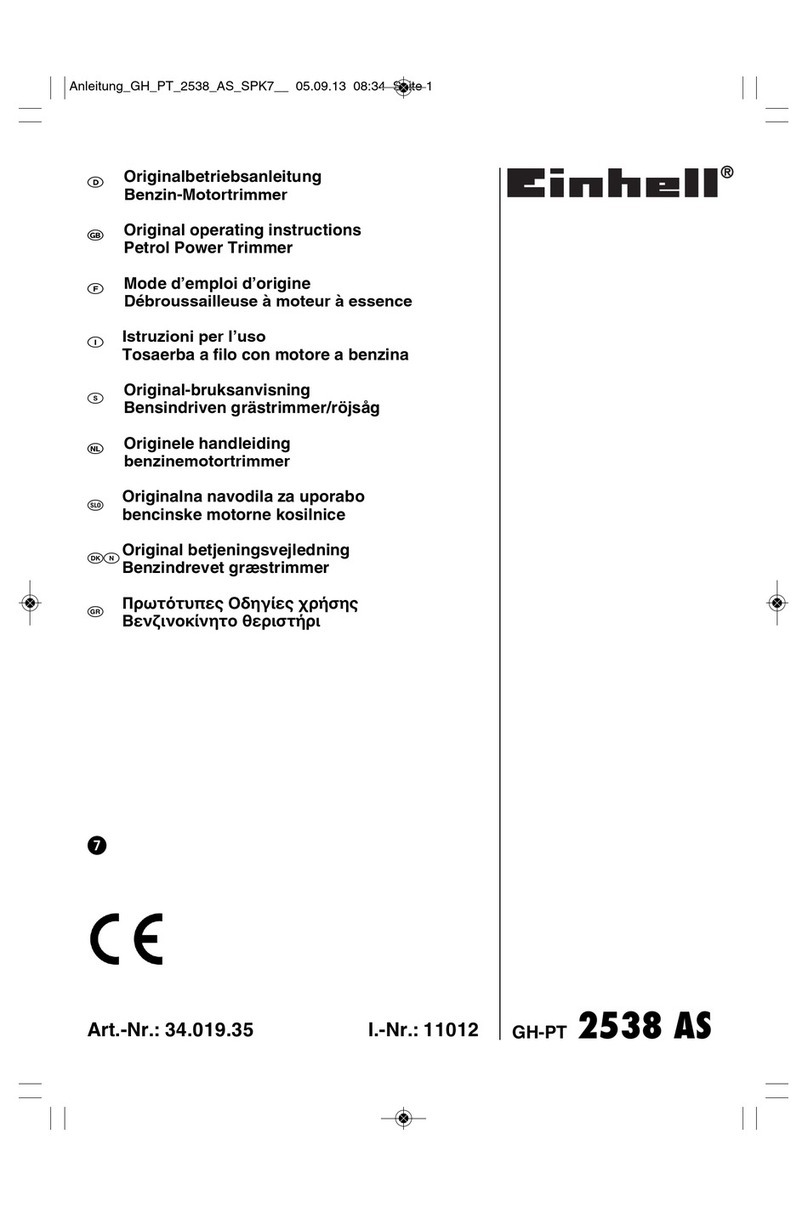
EINHELL
EINHELL GH-PT 2538 AS Original operating instructions
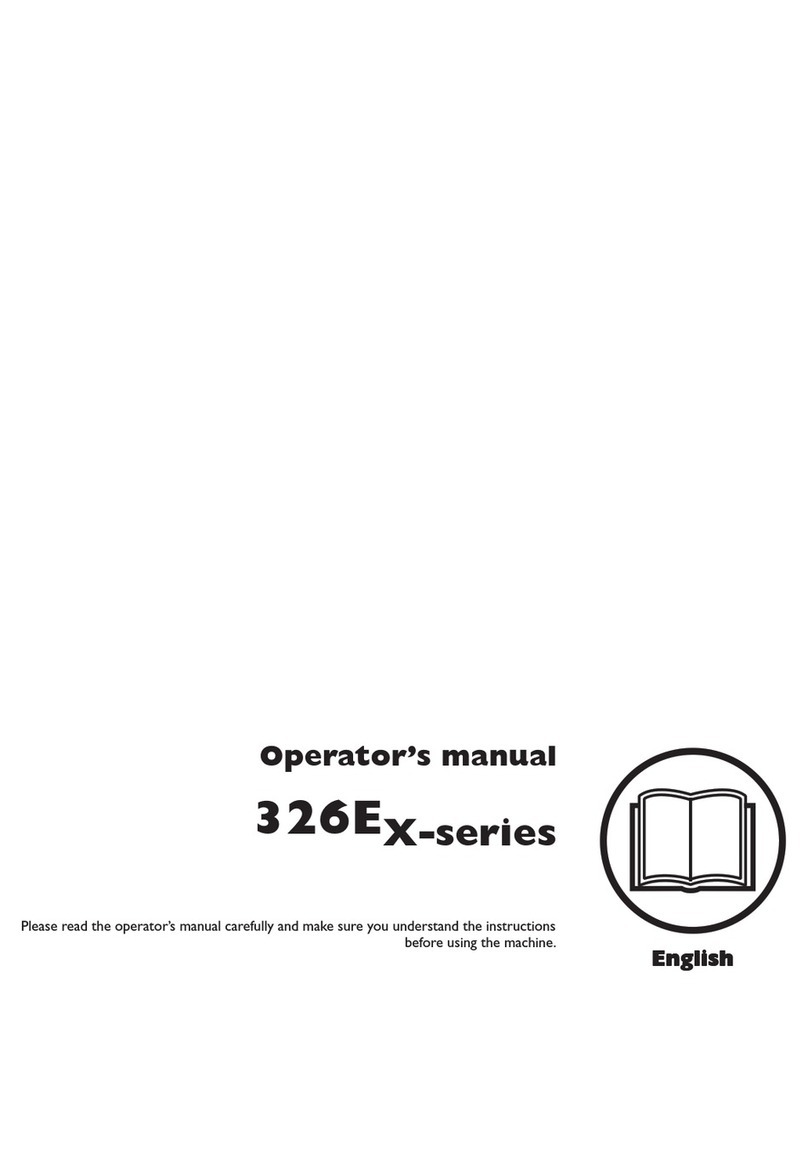
Husqvarna
Husqvarna 326EX series Operator's manual
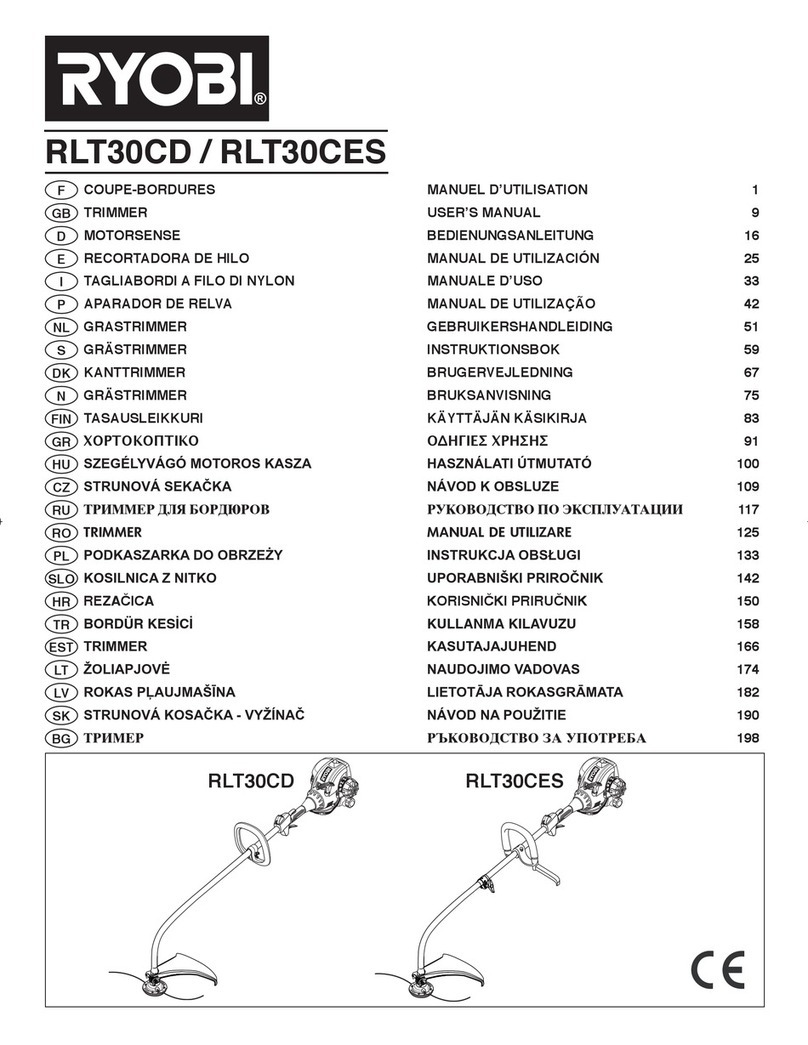
Ryobi
Ryobi RLT30CD user manual
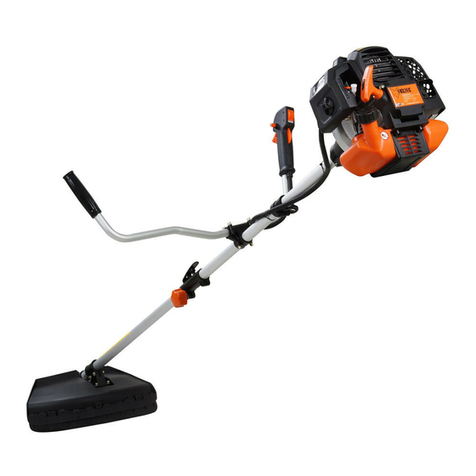
FUXTEC
FUXTEC FX-MS152 manual

Grizzly
Grizzly EHS 600-61 R Translation of the original instructions for use

Craftsman
Craftsman Incredi-Pull 316.99010 Operator's manual
